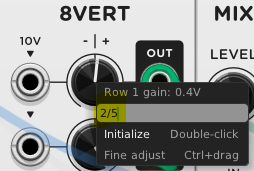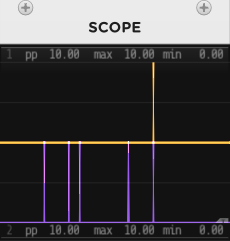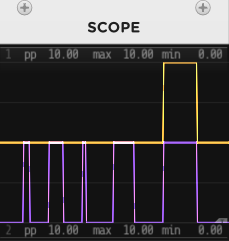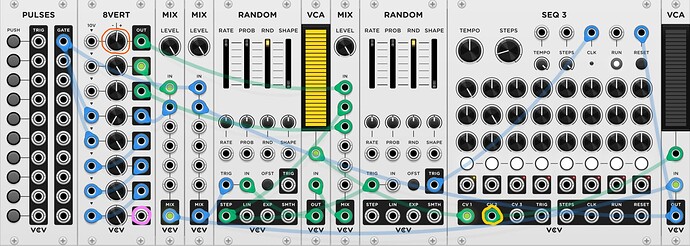Here’s my contribution to this pleasant thread. Had a quick peek at the above patches and I don’t think I’ll be duplicating any of them, even though some are quite similar.
This is a clock divider of sorts, but which will accept any multiple.
The triggers or gates don’t have to come from a steady clock signal; they can be out-of-sync / random and it will still work. So basically, at every nth trigger/gate, it will let that signal through. To test the patch, I used the PULSES module, but you can easily replace this with any clock, LFO, midi input, etc.
To accomplish this, I started with the RANDOM module. Knowing that it takes at least a 2V signal to trigger it, I just had to complete the expression 2 / n (where n being the number of beats… ex : if n = 5, the trigger/gate will go through at every fifth beat)
Now that simple expressions can be entered when right-clicking on a knob, I apply this logic to the first knob of the 8VERT module (circled in orange in the above graphic) :

Then with another RANDOM module (plus a MIX module), I can store these increments with some S&H. So with the 2 / 5 example, the following values will be held :
- 0 + (2 / 5) = 0.4V
- 0.4 + (2 / 5) = 0.8V
- 0.8 + (2 / 5) = 1.2V
- 1.2 + (2 / 5) = 1.6V
- 1.6 + (2 / 5) = 2.0V
Once the 2.0V value is obtained, there’s a bit of resetting going so that the cycle can repeat.
If you want the original trigger/gate to be perfectly aligned (at the exact same sample) with the one that goes through the divider, use the last 8VERT output (circled in pink in the above graphic) and the CV2 output of the SEQ3 module (circled in yellow in the above graphic).
Works just as well with triggers…

…as with gates

Something I haven’t explored yet with this patch is modulating the first CV input in 8VERT. Could yield interesting results ![]()
clock divider (any multiple).vcv (1.5 KB)
